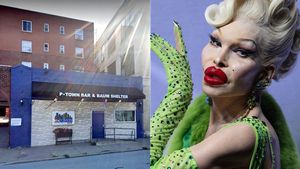Walking down Castro Street on a Sunday afternoon, just beyond where Divisadero veers to the right, I saw a naked old man walking toward me.
By old, I mean -- at 25 paces -- he looked to be nearly my age. Should I look away? His torso was trimmer than mine; his legs less sturdy. His hair as thin.
The old man looked straight ahead, as beautiful young women learn to do. He was wearing sandals. My curiosity about his nakedness was none of his concern.
Public nakedness seems a relict of the last century in San Francisco, now that the city has become the real capital of digital Nowhere, a city clamorous with the sounds of breaking and building -- a place where a young visionary class is deliriously rewarded for inventing the ways we leave our bodies behind.
A rotary of men who gathered for recreational nakedness in a small triangular park on upper Market Street seemed to have no context. Doubtless, preoccupied Pan was headed to join his confreres in the minipark.
The naked men of San Francisco were accustomed to sit on garden chairs, to chat, as men anywhere in the world might take their ease and chat in the sun. But these men insisted on wearing their bodies on city streets. Their bodies were jeremiads; their bodies insisted that this spectacle -- not just the spectacle of badgers showing bunt, but of human bodies en plein air -- is, after all, only what humans look like, only what humans are, when youth and batteries fail.
You will recall that when King Lear takes off his clothes, he offends majesty. The scandal of Lear's abrogation is that, without raiment, a king is a frail, poor creature, indistinguishable from a groundling; his kingdom is disarmed.
When the Royal Shakespeare Company played in Royce Hall at U.C.L.A., the audience was seated on stage, to either side of the playing area. I was as close to King Lear as I am to you. Sir Ian McKellen played Lear. There was no scandal to McKellen's nakedness, only an idiotic reverence on the part of the audience for what Sir was willing to risk for his art. His private parts, likely powdered for the stage, seemed to enjoy the excursion, regardless of what the old man's head declaimed: "Thou art the thing itself. Unaccommodated man is no more but such a poor, bare, forked animal as thou art."
Supervisor Scott Wiener, who represents San Francisco's District 8, which includes the Castro district, took offense to the naked men on the part of public taste and initiated a ban on nudity on streets, sidewalks, plazas and medians, while permitting nudity at certain beaches and street festivals.
On those weekends before the teddy bears' picnic was declared illegal by City Hall, young men and women passed the naked men by without paying them much mind, as did the general populace of District 8, as far as I could tell. I seemed to be the exception. Had they been nude young men, I would have felt compelled to check my messages or take another path.
One afternoon I watched as a seminary of teenage girls from Japan came upon the satyrs in their glade. Obligatory shrieks of surprise from the girls, who, nevertheless, approached the old men. Conversation ensued; cellphones were raised; memorial selfies created: San Francisco, 2012.
Paul Monette, the writer, whom I did not know well, was driving that morning. Cesar sat in the front seat. I was wedged between two men in the back seat. One of the two had something to do with Hollywood, something to do with Barbara Eden. Could that be right? Anyway, he begged my pardon for elbowing me as he repositioned himself.
The car was small; the windows were steamed; the weather must have been cold or wet. We were driving down to Belmont, now a part of greater Silicon Valley, at that time a Peninsula suburb. Within 10 years, everyone in the car would be dead, except me. The man to my left raised his right arm that had fallen asleep. As he did so, his cuff brushed my cheek. I remember that day most poignantly as the feel of cashmere.
Bodies are real. Once youth passes, we carry our bodies around with a growing sense of estrangement from them, though we fear leaving our bodies behind.
Covering our bodies is a lifelong preoccupation, a disguise that represents a revelation. Most people my age have inherited the duty of clearing out the closet of a parent, spouse, lover or friend. The coats. Suits. Smell. Shine. The stripes, pinks, paisleys. Shoes! How can shoes retain the shape of souls? But they do.
That evening, on our return from Belmont, we went to a restaurant on Noe Street. Cesar recited Rimbaud between courses, I recall. (I passed by the restaurant the other day; it is still a French restaurant.) Cesar recounted an adventure he took as a young man. On a whim, he drove a red Peugeot from Paris to Kabul. It was April, Cesar said, as if that were explanation enough. Rimbaud traveled three continents. He died at 37.
During the AIDS years, raised violet lesions -- proofs positive of intimacy -- betrayed intimacy by betraying the body in public. The marked young man must still make his rounds with downcast eyes, walking with a cane. People passing looked away. The young man felt himself disappearing, from his clothes, from his mirror, from his eyes.
From Rimbaud to Rambo: It became the fashion of some gay men in those years to arm themselves with muscles, as much as with condoms. Mr. Clean became an advertisement of health. A delusional gay male fantasy was developed in gyms, modeled on an aesthetic of strength as purity.
During the plague years, designers like Calvin Klein and Gianni Versace placed models in their magazine ads who wore nothing or nearly nothing. By crossing images of the enviable nude body and the fashionably clothed body, they were equating those two states.
Calvin Klein intuited how best to market the equation to the middle class: In an ad for CK underwear, on a billboard over Times Square, Mark Wahlberg, a snarl disfiguring his face, grabbed his own crotch -- as in: "Eat my shorts." Wahlberg's pugnacious vulgarity embarrassed the viewer's interest. The tortuous message nevertheless sold underpants: Desire to dress as someone who loathes your desire.
In 1971, a decade before Wahlberg, Yves Saint Laurent, the most gifted couturier of his generation, had himself photographed nude by Jeanloup Sieff. Saint Laurent was selling, as it were, his scent, so nudity made some kind of sense. He wore the signature black-rimmed glasses by which we recognized him. His body was a faun's body. His pose a mermaid's pose.
His gaze was predatory. His gaze reminds me of the gaze of the blank-faced teenaged boy who locks himself in the bathroom to stand in front of the mirror, to film his naked torso with a cellphone, attempting objectivity by submitting his body to a digital stranger, that stranger himself. Who is the voyeur?
This is excerpt from "Sign of The Times: Nakedness in a Digital Age" at T: The New York Times Style Magazine. Read the full story here.
Pictured, clockwise from left: Yves Saint Laurent photographed by Jeanloup Sieff (1971); Mark Wahlberg for Calvin Klein (1991); Gianni Versace ad by Richard Avedon (1994); Marc Jacobs by Juergen Teller (2010); David Beckham for Emporio Armani (2008); Jon Kortajarena for Tom Ford Eyewear (2009); Nick Kamen for Levi's (1985).




















































